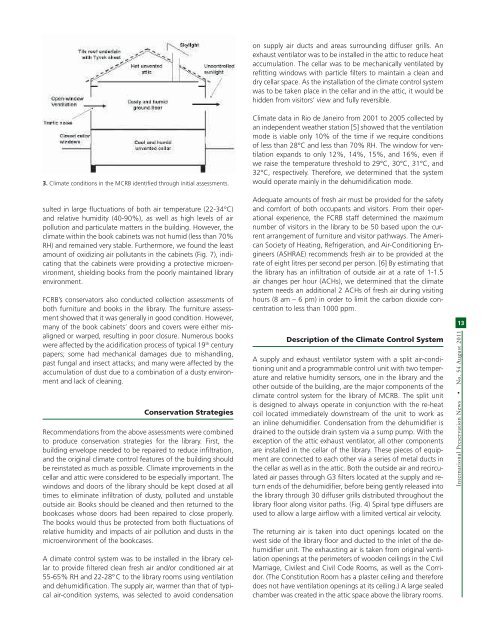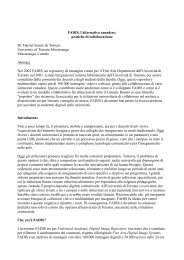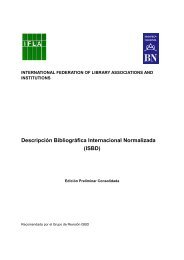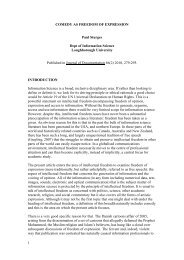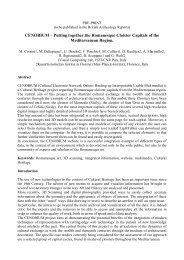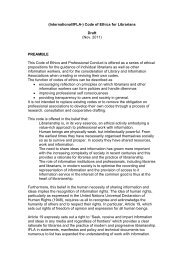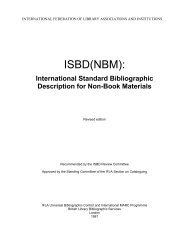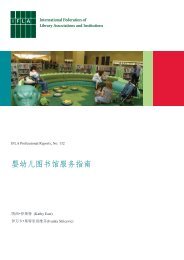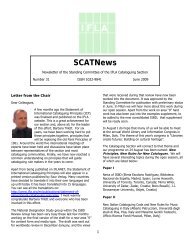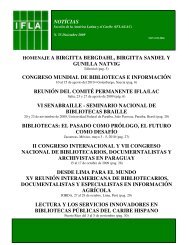N o 54 - IFLA
N o 54 - IFLA
N o 54 - IFLA
Create successful ePaper yourself
Turn your PDF publications into a flip-book with our unique Google optimized e-Paper software.
on supply air ducts and areas surrounding diffuser grills. An<br />
exhaust ventilator was to be installed in the attic to reduce heat<br />
accumulation. The cellar was to be mechanically ventilated by<br />
refitting windows with particle filters to maintain a clean and<br />
dry cellar space. As the installation of the climate control system<br />
was to be taken place in the cellar and in the attic, it would be<br />
hidden from visitors’ view and fully reversible.<br />
3. Climate conditions in the MCRB identified through initial assessments.<br />
sulted in large fluctuations of both air temperature (22-34°C)<br />
and relative humidity (40-90%), as well as high levels of air<br />
pollution and particulate matters in the building. However, the<br />
climate within the book cabinets was not humid (less than 70%<br />
RH) and remained very stable. Furthermore, we found the least<br />
amount of oxidizing air pollutants in the cabinets (Fig. 7), indicating<br />
that the cabinets were providing a protective microenvironment,<br />
shielding books from the poorly maintained library<br />
environment.<br />
FCRB’s conservators also conducted collection assessments of<br />
both furniture and books in the library. The furniture assessment<br />
showed that it was generally in good condition. However,<br />
many of the book cabinets’ doors and covers were either misaligned<br />
or warped, resulting in poor closure. Numerous books<br />
were affected by the acidification process of typical 19 th century<br />
papers; some had mechanical damages due to mishandling,<br />
past fungal and insect attacks; and many were affected by the<br />
accumulation of dust due to a combination of a dusty environment<br />
and lack of cleaning.<br />
Conservation Strategies<br />
Recommendations from the above assessments were combined<br />
to produce conservation strategies for the library. First, the<br />
building envelope needed to be repaired to reduce infiltration,<br />
and the original climate control features of the building should<br />
be reinstated as much as possible. Climate improvements in the<br />
cellar and attic were considered to be especially important. The<br />
windows and doors of the library should be kept closed at all<br />
times to eliminate infiltration of dusty, polluted and unstable<br />
outside air. Books should be cleaned and then returned to the<br />
bookcases whose doors had been repaired to close properly.<br />
The books would thus be protected from both fluctuations of<br />
relative humidity and impacts of air pollution and dusts in the<br />
microenvironment of the bookcases.<br />
A climate control system was to be installed in the library cellar<br />
to provide filtered clean fresh air and/or conditioned air at<br />
55-65% RH and 22-28° C to the library rooms using ventilation<br />
and dehumidification. The supply air, warmer than that of typical<br />
air-condition systems, was selected to avoid condensation<br />
Climate data in Rio de Janeiro from 2001 to 2005 collected by<br />
an independent weather station [5] showed that the ventilation<br />
mode is viable only 10% of the time if we require conditions<br />
of less than 28°C and less than 70% RH. The window for ventilation<br />
expands to only 12%, 14%, 15%, and 16%, even if<br />
we raise the temperature threshold to 29°C, 30°C, 31°C, and<br />
32°C, respectively. Therefore, we determined that the system<br />
would operate mainly in the dehumidification mode.<br />
Adequate amounts of fresh air must be provided for the safety<br />
and comfort of both occupants and visitors. From their operational<br />
experience, the FCRB staff determined the maximum<br />
number of visitors in the library to be 50 based upon the current<br />
arrangement of furniture and visitor pathways. The American<br />
Society of Heating, Refrigeration, and Air-Conditioning Engineers<br />
(ASHRAE) recommends fresh air to be provided at the<br />
rate of eight litres per second per person. [6] By estimating that<br />
the library has an infiltration of outside air at a rate of 1-1.5<br />
air changes per hour (ACHs), we determined that the climate<br />
system needs an additional 2 ACHs of fresh air during visiting<br />
hours (8 am – 6 pm) in order to limit the carbon dioxide concentration<br />
to less than 1000 ppm.<br />
Description of the Climate Control System<br />
A supply and exhaust ventilator system with a split air-conditioning<br />
unit and a programmable control unit with two temperature<br />
and relative humidity sensors, one in the library and the<br />
other outside of the building, are the major components of the<br />
climate control system for the library of MCRB. The split unit<br />
is designed to always operate in conjunction with the re-heat<br />
coil located immediately downstream of the unit to work as<br />
an inline dehumidifier. Condensation from the dehumidifier is<br />
drained to the outside drain system via a sump pump. With the<br />
exception of the attic exhaust ventilator, all other components<br />
are installed in the cellar of the library. These pieces of equipment<br />
are connected to each other via a series of metal ducts in<br />
the cellar as well as in the attic. Both the outside air and recirculated<br />
air passes through G3 filters located at the supply and return<br />
ends of the dehumidifier, before being gently released into<br />
the library through 30 diffuser grills distributed throughout the<br />
library floor along visitor paths. (Fig. 4) Spiral type diffusers are<br />
used to allow a large airflow with a limited vertical air velocity.<br />
The returning air is taken into duct openings located on the<br />
west side of the library floor and ducted to the inlet of the dehumidifier<br />
unit. The exhausting air is taken from original ventilation<br />
openings at the perimeters of wooden ceilings in the Civil<br />
Marriage, Civilest and Civil Code Rooms, as well as the Corridor.<br />
(The Constitution Room has a plaster ceiling and therefore<br />
does not have ventilation openings at its ceiling.) A large sealed<br />
chamber was created in the attic space above the library rooms.<br />
13<br />
International Preservation News • No. <strong>54</strong> August 2011


